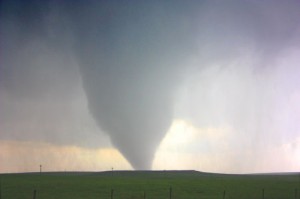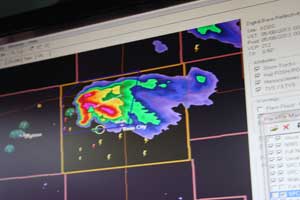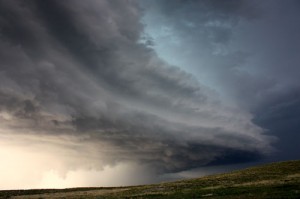This is storm chasing
 Storm chasing is about chasing (or actually get ahead of) the superstorms that occur in the US Midwest plains during spring and summer. People may do it for many different reasons but experiencing and photographing supercells and tornadoes is the most common one.
Storm chasing is about chasing (or actually get ahead of) the superstorms that occur in the US Midwest plains during spring and summer. People may do it for many different reasons but experiencing and photographing supercells and tornadoes is the most common one.
A giant tornado in Kansas stretching out from an eerily green cloud and reaching a field is sight you will always take with you. A perfectly rounded supercell, that looks like a stack of pancakes whilst it’s hovering across a corn field in Nebraska, completely isolated from other clouds, is another sight that will forever change how you look at the skies.
How to chase storms
When you chase storms with an organized tour you do it in a van, with a handful of other storm chasers, led by an experienced guide that is typically a meteorologist. The length of the tours vary, you can go on a one day-tour but most are between 7 and 11 days. This is due to storm chasing being quite travel intensive and you will want to maximize your chances of encountering the best storms at the time.
You start and end in the same city – in the spring and early summer this is usually in Oklahoma City, Oklahoma, but later on in the summer you tend to chase further up North so the base city is typically Denver, Colorado. Every day the tour guide reads up on recent meteorological data and makes a prognosis about the next couple of days, but most importantly the current day. Using this prognosis, he then decides where in the Midwest the group should be heading to have the best chance of encountering the storms.
 While heading for the area of interest the tour guide is getting constantly updated on recent weather data in order to fine tune, or alter, the chosen direction. Once in place it is usually a matter of keeping track of radar images for signs of convection, normal clouds that grow rapidly into towering cumulonimbus, and thunderstorms. The tour guide chooses one of these towering clouds and positions the group in front of it, waiting for it to start rotating as it becomes a supercell thunderstorm – which happens under the right circumstances.
While heading for the area of interest the tour guide is getting constantly updated on recent weather data in order to fine tune, or alter, the chosen direction. Once in place it is usually a matter of keeping track of radar images for signs of convection, normal clouds that grow rapidly into towering cumulonimbus, and thunderstorms. The tour guide chooses one of these towering clouds and positions the group in front of it, waiting for it to start rotating as it becomes a supercell thunderstorm – which happens under the right circumstances.
On a good chase day you might follow several thunderstorms while they grow into supercells – pouring out hail, thousands of lightning bolts and possibly also a tornado. If you are really lucky you may encounter a “tornado outbreak” – a day when the storms produce tornadoes after tornadoes. These days, however, are rare.
Chasing storms is actually not the most accurate term for what you are doing during a ‘chase’ since you are actively trying to stay ahead of the storm. This is so you can see the storm better and stay in a safe place. You will do this until it gets too dark, and impossible to continue the chase, at which point your tour guide will steer away from the storm towards the next day’s site so that everyone can enjoy a late night dinner and some well deserved rest before everything starts all over again the next day.
Every day has its own unique conditions
Some days the chase will be amazing and some days will be less exciting. During bad days you may just travel to get into a better position for the day after, or stay in the location perhaps taking the opportunity to visit an area of interest (like a National Park). Typically, not all days will be days where you will have perfect storms to chase but chasing storms is of course the number one priority so the tour guide will go after anything that may produce severe weather. With the whole Midwest as your ‘playing field’ the chances are excellent that there is a severe thunderstorm within reach, during tornado season.
Since you will be travelling all over the plains, from Colorado in the West to Missouri in the East and from Texas in the South up to the Dakotas in the North, you will spend a lot of time in the van. You start off the day driving into position and whilst chasing, you drive to stay ahead, so on a good day you may spend over 7-8 hours in the van. Storm chasing is a nature adventure combined with the charm of a road trip in central USA.
What will you experience during a storm chase?
 Storm chasing is a type of safari and just like any type of safari there are no guarantees, only probabilities. It is very likely that you will experience severe thunderstorms and supercells during your storm chasing trip. Tornadoes are usually the most desired things to see but not every tour will experience one. Everything is obviously dependent upon the weather conditions during the time of your tour. The only thing you can be sure of is that the tour guide will do everything in his power and knowledge in order to find tornadoes and supercells, when they occur.
Storm chasing is a type of safari and just like any type of safari there are no guarantees, only probabilities. It is very likely that you will experience severe thunderstorms and supercells during your storm chasing trip. Tornadoes are usually the most desired things to see but not every tour will experience one. Everything is obviously dependent upon the weather conditions during the time of your tour. The only thing you can be sure of is that the tour guide will do everything in his power and knowledge in order to find tornadoes and supercells, when they occur.
Even if tornadoes are typically considered the jackpot of a tour, many people tend to be just as fascinated by amazing supercell structures. The colors, shapes and constellations a supercell can produce are something that you are unlikely to have never seen before.
If you want to see some examples of what you might encounter during storm chase, please check out our photos and videos page.
Newsletter
Sign up for our newsletter, the first step towards going on your storm chasing trip. By registering you accept the terms and conditions
Testimonials
I had an awesome time with Tempest. The staff is very helpful with the
booking process and all throughout the trip; tour director (Bill Reid)
and the drivers (Jen and Chris) have been extremely clear during their
weather briefing and explaining what was going on with the developing
weather in general.
I chased two back-to-back tours with Tempest in 2013 and had a great time! Their skilled guides get you a ringside seat on the best storms, not to mention being helpful, funny, and great educators into the bargain. ‘Safety-first’ is no idle boast, and I was very impressed by their dedication to keeping me safe through all aspects of the chase.







Leave a Reply